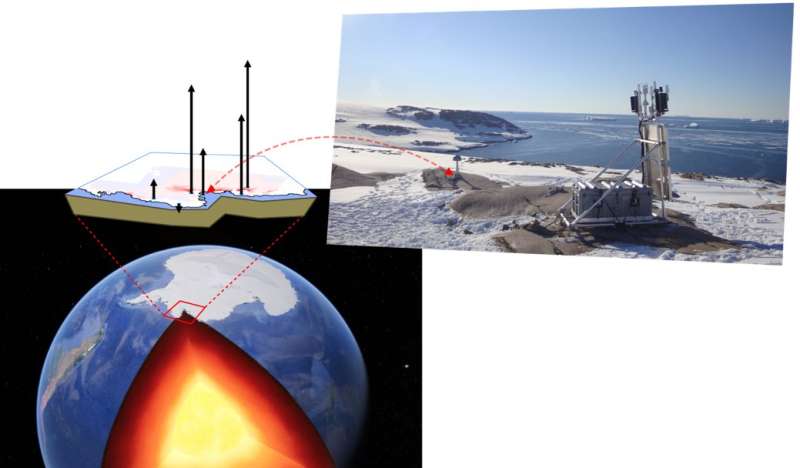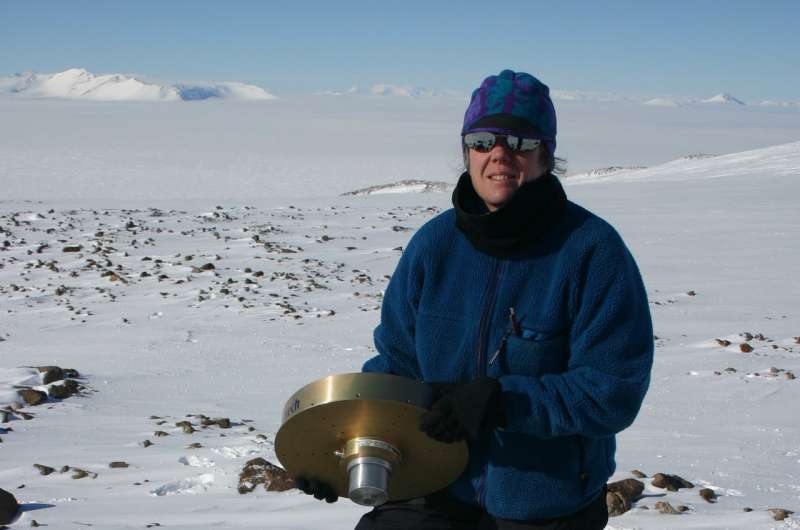Bedrock in West Antarctica rising at surprisingly rapid rate

The earth is rising in one part of Antarctica at one of the fastest rates ever recorded, as ice rapidly disappears and weight is lifted off the bedrock, a new international study has found.
The findings, reported in the journal Science, have surprising and positive implications for the survival of the West Antarctic Ice Sheet (WAIS), which scientists had previously thought could be doomed because of the effects of climate change.
The unexpectedly fast rate of the rising earth may markedly increase the stability of the ice sheet against catastrophic collapse due to ice loss, scientists say.
Moreover, the rapid rise of the earth in this area also affects gravity measurements, which implies that up to 10 percent more ice has disappeared in this part of Antarctica than previously assumed.
Researchers led by scientists at The Ohio State University used a series of six GPS stations (part of the POLENET-ANET array) attached to bedrock around the Amundsen Sea Embayment to measure its rise in response to thinning ice.
The "uplift rate" was measured at up to 41 millimeters (1.6 inches) a year, said Terry Wilson, one of the leaders of the study and a professor emeritus of earth sciences at Ohio State.
In contrast, places like Iceland and Alaska, which have what are considered rapid uplift rates, generally are measured rising 20 to 30 millimeters a year.
"The rate of uplift we found is unusual and very surprising. It's a game changer," Wilson said.
And it is only going to get faster. The researchers estimate that in 100 years, uplift rates at the GPS sites will be 2.5 to 3.5 times more rapid than currently observed.
"These results provide an important contribution to our understanding of the dynamics of the Earth's bedrock, along with the thinning of ice in Antarctica. The large amount of water stored in Antarctica has implications for the whole planet," said lead study author Valentina R. Barletta, who started this work at Ohio State and now is a postdoctoral researcher at the National Space Institute (DTU Space) at the Technical University of Denmark.
"The new findings raise the need to improve ice models to get a more precise picture of what will happen in the future."
While modeling studies have shown that bedrock uplift could theoretically protect WAIS from collapse, it was believed that the process would take too long to have practical effects.
"We previously thought uplift would occur over thousands of years at a very slow rate, not enough to have a stabilizing effect on the ice sheet. Our results suggest the stabilizing effect may only take decades," Wilson said.
Wilson said the rapid rise of the bedrock in this part of Antarctica suggests that the geology underneath Antarctica is different from what scientists had previously believed.
Underneath the solid upper layer of Earth is a hotter and more fluid layer of rock called the mantle. Exactly how hot and fluid the mantle is varies across the planet.
The rapid uplift around the Amundsen Sea Embayment suggests that the mantle in this area is hotter and more fluid (or, as scientists say, it has lower viscosity) than expected, according to Barletta.
Barletta ran a variety of computer models using scenarios of ice loss through time in the area to explain how such rapid uplift could be occurring today.

The results of Barletta's models showed that the GPS findings today could best be explained by having a low-viscosity mantle, Wilson said.
That would mean the bedrock reacts more quickly when the weight of ice is removed—which is exactly what the GPS results showed.
These new measurements of Glacial Isostatic Adjustment (GIA), the scientific term for uplift due to ice sheet unloading, are an important part of a wider story about the fate of the Antarctic ice sheets, said Doug Kowalewski, the Antarctic Earth Sciences program director in the National Science Foundation's Office of Polar Programs (OPP).
"The observed GIA response captured by the POLENET array is an order of magnitude greater than previously thought. The upcoming challenge is to couple the GIA observations with ice-sheet models," Kowalewski said.
"These data will be of great value to the modeling community who examine the complex relationships between GIA, sub-ice shelf ocean circulation, and ultimately, ice sheet stability."
The biggest practical effect of the uplift may be a rare bit of good news for what is happening in this part of Antarctica as a result of climate change, Wilson said.
The West Antarctic Ice Sheet plays a key role in sea level rise. Estimates suggest this ice sheet alone accounts for one-fourth of global sea level rise that can be attributed to disappearing snow and ice.
Some scientists suggest that WAIS may have passed a tipping point in which ice loss can no longer be stopped, which could be catastrophic, Wilson said. The glaciers there contain enough water to raise global sea levels up to four feet.
The problem is that much of this area of Antarctica is below sea level. Relatively warm ocean water has flowed in underneath the bottom of the ice sheet, causing thinning and moving the grounding line—where the water, ice and solid earth meet—further inland.
The process seemed unstoppable, Wilson said. "But we found feedbacks that could slow or even stop the process."
One important feedback involves "pinning points—elevated features of the earth rising from the surface below the grounding line that pin the ice sheet to solid earth. These pinning points are going up in response to the uplift of the earth and could prevent further retreat of the ice sheet.
Another feedback is lowering sea levels. Massive ice sheets along the ocean have their own gravitational pull and raise the sea level near them. But as the ice thins and retreats, the gravitational pull lessens and the sea level near the coast goes down.
"The lowering of the sea level, the rising of pinning points and the decrease of the inland slope due to the uplift of the bedrock are all feedbacks that can stabilize the ice sheet," Wilson said.
Other researchers had estimated how much the earth would have to rise to protect WAIS given a range of future climate warming scenarios.
Results of this study estimate that the bedrock at the Pine Island Glacier grounding line (which is part of WAIS) will have risen about 8 meters in 100 years. That is about three times higher than values shown by others to reduce run-away retreat in this area.
"Under many realistic climate models, this should be enough to stabilize the ice sheet," Wilson said.
She said while this study delivers some potentially good news for the Amundsen Sea Embayment, that doesn't mean all is well in Antarctica.
"The physical geography of Antarctica is very complex. We found some potentially positive feedbacks in this area, but other areas could be different and have negative feedbacks instead," she said. Regardless of feedbacks, models suggest that the WAIS will collapse if future global warming is large.
More information: V.R. Barletta el al., "Observed rapid bedrock uplift in Amundsen Sea Embayment promotes ice-sheet stability," Science (2018). science.sciencemag.org/cgi/doi … 1126/science.aao1447
Journal information: Science
Provided by The Ohio State University



















